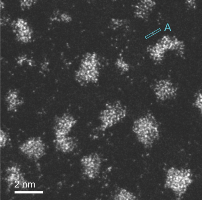Catalyst for change
CEEM’s researchers’ work in developing of state-of-the-art atomic resolution microscopes is helping to transform the UK specialty chemicals industry – especially in the field of catalysis, where the ability to arrange, control and anchor materials on a nanometer scale is critical to success.
By adapting and refining existing advanced JEOL microscopes CEEM has developed the world’s first and only aberration corrected environmental scanning transmission electron microscope (AC ESTEM) which enables novel studies of nanoparticle catalysts with Angstrom (0.1 nm) resolution in gas: allowing researchers to actually 'see' and analyse individual atoms within materials.
“Our technology has been a reality check for scientists and researchers,” says Professor Boyes, who first began working on this technology when he and Professor Pratibha Gai were senior research fellows with the global science and engineering company, DuPont.
CEEM’s fundamental research, coupled with the development of unique atomic resolution microscopy, is providing a much stronger evidence and science-base for companies like Johnson Matthey and DuPont whose catalytic materials are key to the creation of cleaner, more energy efficient technologies.
“All too often new materials are just stumbled upon and how they work is something of a black art. By pushing the boundaries of microscopy we can help provide academic researchers and industrial R&D teams with a more rational basis for the design and manufacture of new materials,” he added.
Contact us
Centre for Energy Efficient Materials
ceem@york.ac.uk
+44 (0)1904 322251
School of Physics, Engineering and Technology,
University of York,
Heslington,
York,
YO10 5DD
“Our new design is the only one of its kind and is already attracting interest from industry, as many technological processes occur at the gas-solid interface where direct observation using atomic resolution electron microscopy provides an unrivalled tool for understanding their evolution.”
With industry leaders and policy makers increasingly concerned that many of the rare earths that are currently used in the creation of high-performance catalysts are a scarce resource, and often mined in environmentally damaging ways, the search is on for more sustainable alternatives.
Our research is helping to guide that search in the right direction. The combination of first principles predictive modelling using high-powered computers and experimentation informed by world leading microscopy, is proving a powerful catalyst for developing the next generation of clean, energy efficient, materials.
With researchers like Boyes and Gai who have held senior R&D roles within world leading science-based companies such as DuPont, CEEM has a culture that is determined to use its knowledge to make a difference in the wider world. Indeed, Johnson Matthey recently made a multimillion-pound investment in the kind of technology being developed by CEEM.
Contact us
Centre for Energy Efficient Materials
ceem@york.ac.uk
+44 (0)1904 322251
School of Physics, Engineering and Technology,
University of York,
Heslington,
York,
YO10 5DD
